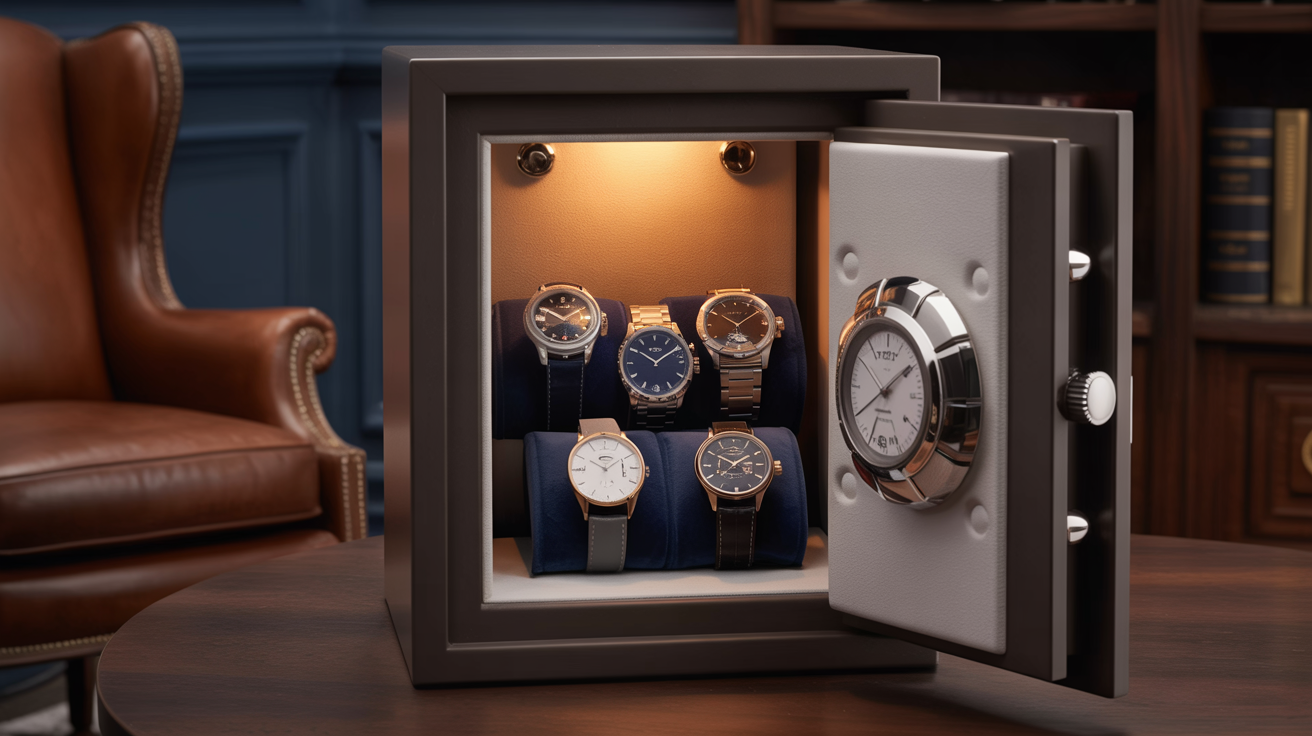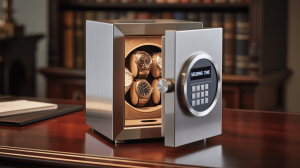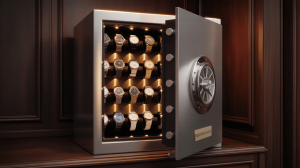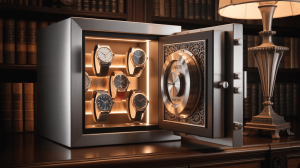Compact Watch Safes: Sleek Protection for Small Spaces. But here’s the kicker… Safeguarding timepieces in tight areas calls for clever design that blends function with minimal footprint.
1. What Defines a Compact Watch Safe?
● Small footprint for desks or shelves
● Secure locking mechanism that resists tampering
● Padded interior to prevent scratches during transit
● Lightweight yet sturdy construction for easy placement
What’s the real story? A compact safe must fit tight spots without compromising security or style. It should be small enough to tuck away discreetly yet strong enough to withstand impact or unauthorized access.
| Feature | Benefit | Notes |
|---|---|---|
| Lock Type | Digital or key lock | Balance access and safety |
| Interior Padding | Foam or velvet lining | Prevents surface damage |
| Exterior Size | Fits narrow shelves | Ideal for small rooms |
| Weight | Under 5 pounds | Easy to move |
2. How Small Should a Compact Safe Be?
● Measure available space precisely, including depth
● Consider your largest watch’s case diameter and height
● Allow room for additional straps or small tool kits
● Choose slim depth models that slide into shelves
Here’s the deal: Aim for a case that fits your smallest nook but still holds your watches comfortably without crowding or causing pressure on the dials.
3. Which Locking Mechanisms Work Best in Compact Safes?
● Digital keypad for password‑based access
● Mechanical key lock for simplicity
● Combination dial for reliability
● Biometric sensor in premium models
This is where it gets interesting… Digital locks minimize external hardware, while mechanical locks never fail due to battery issues. Biometric adds speed but at higher cost.
4. What Materials Offer the Best Protection?
● Hardened ABS plastic shell for impact resistance
● Aluminum alloy for light strength and corrosion resistance
● Reinforced steel for maximum security in discreet formats
● Anti‑tamper hinges and hidden joints
But here’s the kicker: Material choice impacts weight, cost, and security level. ABS delivers affordability, aluminum balances weight and resilience, steel delivers ultimate protection.
| Material | Pros | Cons |
|---|---|---|
| ABS Plastic | Light, impact‑resistant | Lower premium feel |
| Aluminum Alloy | Strong, lightweight | Higher price |
| Reinforced Steel | Top security, tamper‑proof | Heavy, costly |
5. Can Compact Safes Be Fireproof?
● Basic fire ratings protect against short bursts of heat
● Fire‑resistant seals and gaskets to block flames
● Insulated walls that slow heat transfer
● Certification from recognized labs
What’s the real story? Full fireproofing adds bulk and cost. Most compact models offer limited heat resistance. If fire is a concern, check for rating of at least 30 minutes.
6. How to Organize Watches Inside a Small Safe?
● Use removable foam inserts shaped for each watch
● Vertical watch pillows to save base area
● Stackable trays for extra straps or bracelets
● Small compartments for cleaning tools or keys
What’s the real story? Proper organization maximizes capacity and ensures each watch stays fixed and protected, avoiding collisions and scratches.
7. Are There Models with Integrated Winders?
● Single‑watch winder modules for one automatic watch
● Dual‑winder configurations in compact shells
● Customizable rotation settings to suit movement types
● Silent motors designed for bedside use
Here’s the deal: Integrated winders add functionality but increase depth and price. Evaluate if you need constant winding or occasional manual winding.
| Model Type | Watches | Depth (inches) | Price Range |
|---|---|---|---|
| Single Winder | 1 | 6 | $150–$300 |
| Dual Winder | 2 | 8 | $300–$500 |
| Modular Winder | 1–4 | 6–10 | $200–$800 |
8. How Important Is Interior Padding?
● Prevents scratches during movement or shocks
● Shock absorption for travel or transport
● Soft lining protects delicate finishes
● Replaceable foam inserts keep interior fresh
What’s the real story? High‑density foam or velvet is essential in a compact safe to shield delicate cases. Regularly inspect padding for compression and replace every couple of years.
9. How to Secure a Compact Safe to Furniture?
● Pre‑drilled anchor holes in the base
● Mounting brackets and screws for desks or shelves
● Anti‑theft cable attachments to fixed points
● Adhesive security plates for non‑invasive anchors
This is where it gets interesting… Anchoring keeps the safe in place without bulky floor bolts, offering discreet security.
10. Can You Hide a Compact Watch Safe?
● Camouflage as a book or decorative box
● Blend with decor using printed or wood finishes
● Under‑desk slots for concealed storage
● Hidden compartments within larger drawers
But here’s the kicker… A disguised exterior deters casual theft. Integrate with furniture pieces to blend seamlessly into your décor.
| Concealment Style | Visibility | Installation |
|---|---|---|
| Book‑Style Safe | Very covert | Slip on shelf |
| Decorative Box | Low | Place in plain sight |
| Drawer Insert | Concealed | Built into drawer |
11. What Power Options Do Integrated Winders Use?
● AC adapter plug‑in for consistent power
● Rechargeable battery packs for flexibility
● USB power sources for travel adapters
● Solar charging panels in eco models
Here’s the real story: Battery‑powered winders free you from outlets but require regular recharging. AC power offers uninterrupted operation.
12. How to Choose Off‑The‑Shelf vs. Custom?
● Standard models are cost‑effective and immediate
● Custom sizes fit unique spaces and aesthetics
● Custom finishes match décor seamlessly
● Lead times vary from immediate to several weeks
Here’s the deal: Off‑the‑shelf gives budget savings; custom ensures a perfect fit and style match, but expect longer delivery times.
| Option | Cost Level | Lead Time |
|---|---|---|
| Standard Model | Low | Immediate |
| Custom Build | High | 4–6 weeks |
13. How Much Should You Invest in a Compact Safe?
● Budget: $50–$100 for basic lock and shell
● Mid‑tier: $100–$250 for padding and small winder
● Premium: $250+ for advanced materials and electronics
What’s the real story? Spending at least $100 provides reliable locks and decent materials. Premium models add features like winders or biometric access for convenience.
14. How to Maintain a Compact Watch Safe?
● Wipe down exterior monthly to remove dust
● Check lock function and keypad quarterly
● Replace batteries annually for winders/locks
● Inspect interior lining for wear and tear
But here’s the kicker… Regular maintenance extends safe lifespan and reliability, ensuring your watches stay protected.
| Task | Frequency | Purpose |
|---|---|---|
| Exterior Wipe | Monthly | Keeps surfaces clean |
| Lock Inspection | Quarterly | Ensures security |
| Battery Replacement | Annually | Supports winders and locks |
15. Conclusion: Sleek Security in Tight Spaces
Compact Watch Safes deliver secure, streamlined protection without hogging room. Ready for the good part? Select a model that fits your décor and space, so your watches remain safe and readily accessible wherever you place them.
FAQ
Q1: What depth should a compact safe have?
Aim for under 8 inches depth to fit most shelves or nightstands.
Q2: Are biometric locks worth it in small safes?
Yes, for fast access and no-key convenience—but ensure battery backup.
Q3: Can a compact safe survive impact?
Yes, models with ABS shells or aluminum alloy resist moderate shocks.
Q4: How often replace foam padding?
Replace every two years or if you notice compression marks.
Q5: Is an integrated winder practical?
It’s useful for daily wear watches but adds depth and cost.







